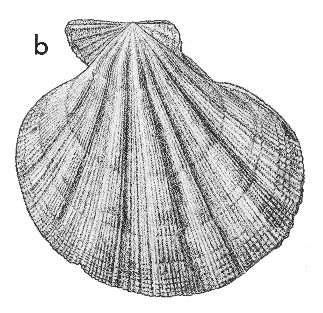
Revised descriptions of New Zealand Cenozoic Mollusca from Beu and Maxwell (1990)

 | Revised descriptions of New Zealand Cenozoic Mollusca from Beu and Maxwell (1990) | 
|
  (Pl. 32b): GS1176, CH/f2, left valve, Momoe-a-Toa Shellbed, Cape Young, northern Chatham Island, early Opoitian (TM4232, GNS) |
  (Pl. 32g): GS1176, CH/f2, right valve, Momoe-a-Toa Shellbed, Cape Young, northern Chatham Island, early Opoitian (TM4232, GNS) |
Beu & Maxwell (1990): Chapter 14; p. 278; pl. 32 b,g.
Synonymy: Pecten dendyi Hutton 1902, p. 196
Type species of Dendopecten Hertlein, 1936 (= Mesopeplum Iredale, 1929)
Classification: Pectinidae
Description: Large for subgenus (47-72 mm high), calcitic, obliquely elongated postero-ventrally, umbo at or a little behind anterior third of length; 2 valves equally inflated. The most prominent sculpture is 6 or 7 radial folds, broad and closely spaced on right valve, narrow and widely spaced on left valve, folding whole shell including commissure; superimposed on and between major folds are many prominent radial costae, low, wide, and closely spaced on right valve, narrow, widely spaced, and with very narrow intermediate costellae on left valve. Entire surface crossed by fine commarginall ridgelets. Ears very unequal; posterior ones small, with posterior margin inclined strongly backward, bearing 2 or 3 narrow radial costellae; anterior ears twice as long as posterior, with antero-ventral margin contracted strongly to disc, without ctenolium in adult, bearing 5 or 6 narrow radial costae. Dorsal margin of right valve ears higher than and bending slightly over dorsal margin of left valve ears. Interior not seen — all specimens articulated.
Comparison: The lack of a ctenolium and the equally convex valves show that, like modern specimens of M. convexum (Pl. 44g), Mesopeplum dendyi was a free-lying species that swam actively to avoid predators. It is larger, more obliquely elongated, and with slightly more numerous radial folds than other M. (Mesopeplum) species, particularly the common species M. convexum, and M. convexum also differs in having the right valve obviously more inflated than the left one.
Distribution: Early Opoitian, Momoe-a-Toa Shellbed, Cape Young, northern Chatham Island (type), the only known locality; abundant, with abundant Sectipecten allani and Zygochlamys seymouri, and rare Mesopeplum (Borehamia) toaense. The abundant pectinids at Momoe-a-Toa occur in tuff and seem to have lived in an off-shore, hard-ground situation.
Cite this publication as: "A.G. Beu and J.I. Raine (2009). Revised
descriptions of New Zealand Cenozoic Mollusca from Beu and Maxwell (1990). GNS
Science miscellaneous series no. 27."
© GNS Science, 2009
ISBN
978-0-478-19705-1
ISSN 1177-2441
(Included with a PDF facsimile file
copy of New Zealand Geological Survey Paleontological Bulletin 58 in CD version
from: Publications Officer, GNS Science, P.O. Box 30368 Lower Hutt, New
Zealand)